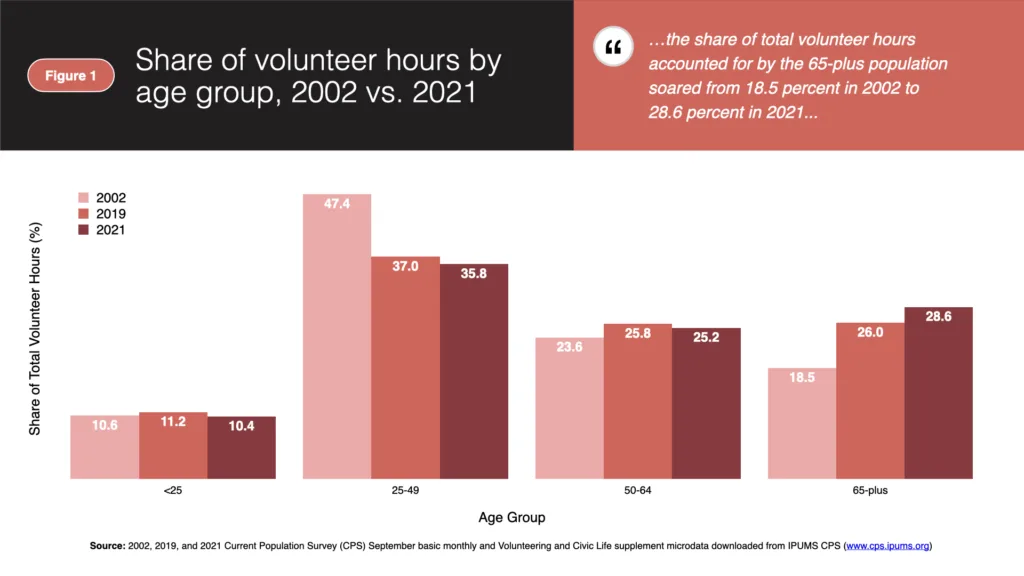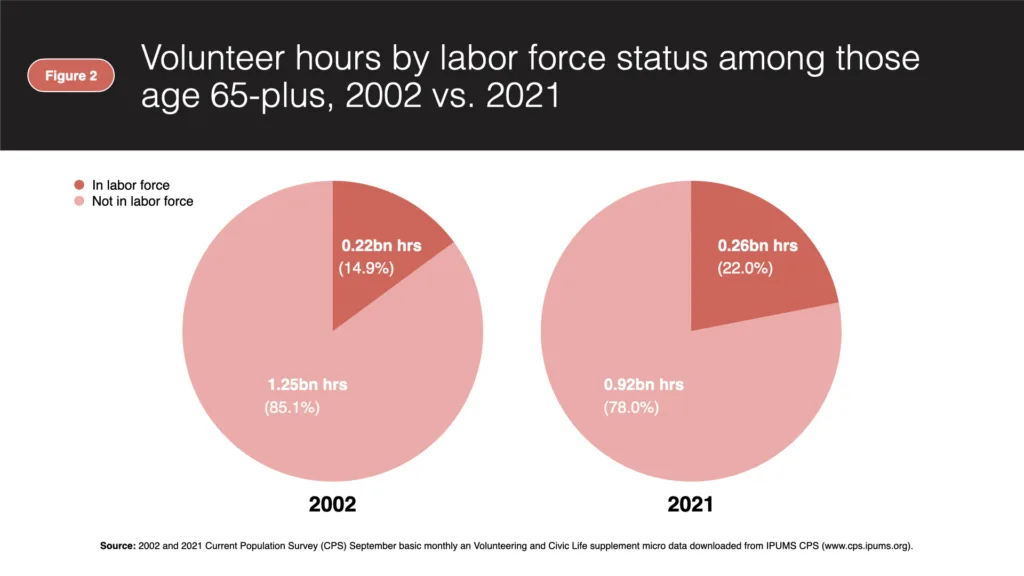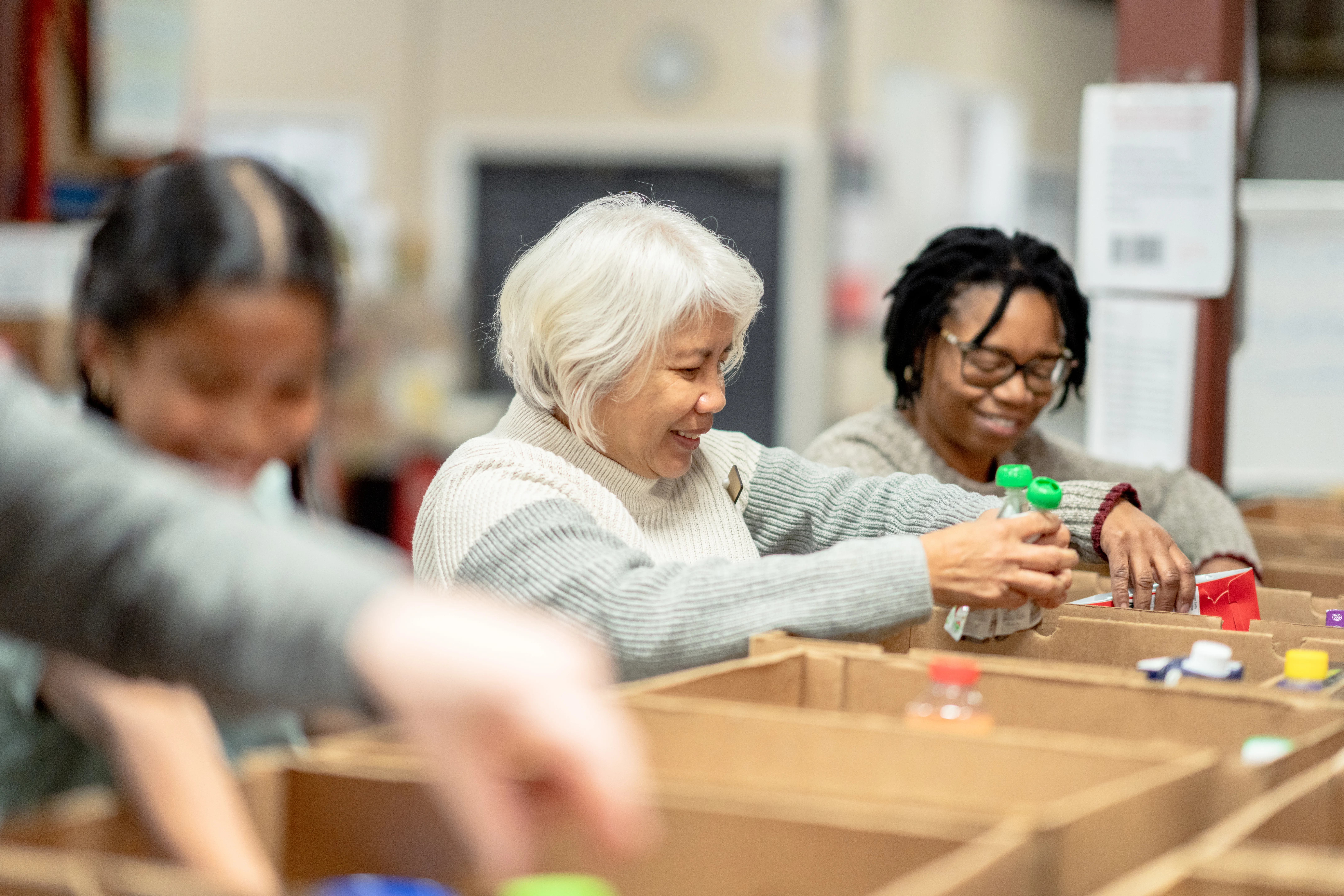Key Takeaways
- Every year, volunteerism in the United States generates over $100 billion in economic activity. However, volunteer rates and hours served have been declining steadily for 20 years.
- Volunteerism among older adults has been comparatively resilient. As a result, the share of total volunteer hours accounted for by the 65-plus population grew from 18.5 percent in 2002 to 28.6 percent in 2021.
- This increase in share has occured despite rising labor force participation in the 65-plus population and the COVID-19 pandemic.
- These revelations are a call to action for practical steps which encourage volunteering and reduce barriers faced by those who wish to give back to their community.
Annually, the economic value of volunteer work in America exceeds $100 billion. Despite increasingly significant attachment to the labor force and other time constraints older adults continue to contribute an outsized percentage of this value. AARP has firsthand knowledge of volunteerism’s critical place in society, as our 50,000-plus volunteers constantly use their experience and know-how to support those in need. In many cases, volunteer contributions supply the only channel through which individuals and communities receive critical goods and services. Unfortunately, the total number of volunteer hours served declined from almost 8 billion hours in 2002 to just 4.1 billion in 2021, resulting in economic and social losses affecting every generation.
Even though volunteerism fell for all age groups between 2002 and 2021, the contributions of older adults were comparatively resilient. In fact, while the total number of volunteer hours served by people under age 65 fell by 54.9 percent during this period, the hours contributed by those age 65-plus fell by just 20.3 percent.1 Consequently, the share of total volunteer hours accounted for by the 65-plus population soared from 18.5 percent in 2002 to 28.6 percent in 2021. Remarkably, this rise in share continued through the pandemic, despite the significantly elevated risk that COVID-19 posed for older adults.

One might dismiss the findings shown above as a simple byproduct of population aging or older adults having more free time available for volunteer activities. However, the 65-plus share of volunteer hours increased by substantially more than the 65-plus share of population between 2002 and 2021.2 In addition, labor force participation in the 65-plus population has grown tremendously in recent decades, which should have put downward pressure on volunteer work in this age group compared to the population at large. Instead, volunteerism in the 65-plus population is increasingly attributable to individuals who are also working or looking for work.
The figure below shows the latter fact by plotting the share of 65-plus volunteer hours attributable to labor force participants and non-participants in 2002 and 2021. In 2002, the entire 65-plus population accounted for roughly 1.47 billion volunteer hours, with over 1.25 billion of those hours coming from people who were not in the labor force. By 2021, the total number of volunteer hours supplied by non-participants aged 65-plus had fallen to about 920 million, while the amount supplied by labor force participants aged 65-plus had grown from 220 million to nearly 260 million. As a result, over one-in-five volunteer hours provided by the 65-plus population in 2021 were contributed by a person who was also working or looking for work, up from just over one-in-seven in 2002.

Older adults have always represented a key part of the volunteer community and recent trends have amplified their role even more. This revelation underscores an enduring commitment to the principles of volunteerism in this age group and is a call to action for practical steps to encourage volunteering and reduce barriers faced by those who wish to give back to their community. AARP is leading the way in this effort via its many volunteer programs and Create the Good, which helps match people with volunteer opportunities aligned with their interests and experience. Steps such as these will support the increasingly critical contributions of older adults and foster greater volunteerism in general, yielding economic and social gains benefitting every generation.
- Most of this decline occurred between 2019 and 2021, when 65-plus volunteer hours fell from 1.41 billion to 1.17 billion. Between 2002 and 2019, 65-plus volunteer hours declined by just 4.3 percent, whereas under-65 volunteer hours declined by 38.2 percent. Even during 2019-2021, the percentage decline in 65-plus volunteer hours (-16.7 percent) was significantly less than that observed for under-65 volunteer hours (-27.1 percent). ↩︎
- The 65-plus share of U.S. population grew from 12.3 to 16.7 percent between 2002 and 2021, an increase of almost 36 percent (see https://fred.stlouisfed.org/series/SPPOP65UPTOZSUSA). In the same period, the 65-plus share of volunteer hours rose by nearly 55 percent. ↩︎

 "
"
